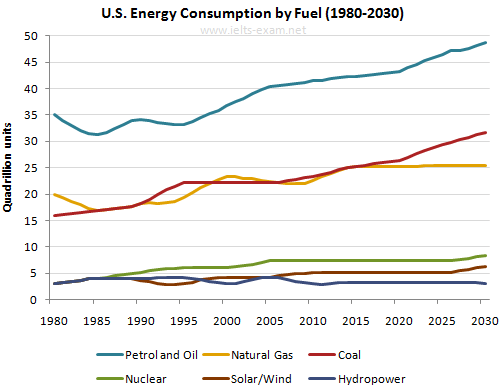The graph below gives information from a 2008 report about consumption of energy in the USA since 1980 with projections until 2030.
Summarise the information by selecting and reporting the main features, and make comparisons where relevant.
The line graph provides information about the consumption of energy by fuel in the United States of America since 1980 with projections until 2030.
The most dominant fuel sources throughout the period are petrol and oil. Starting with 35 quadrillion units in 1980, it reached about 42 quadrillions in 2013. It is estimated that by 2030 this fuel source will reach 48 quadrillion units.
Consumption of energy derived from coal and natural gas is quite smaller. From 20 and 15 quadrillion units in the beginning of the period, natural gas had a slight decline and coal a gradual increase. The two fuels were equal from 1985 to 1990, when coal began to lead. It is predicted that coal will increase steadily to 32 quadrillion units in 2030, while natural gas will remain stable at 25 quadrillion units.
The least prevailing fuel sources in this period are nuclear, hydropower, solar and wind. All of the fuels started with 4 quadrillion units in 1980. Thereafter, nuclear risen to 7 quadrillion units in 2010, while at the same time solar and wind increased only by 1 quadrillion unit. Hydropower had some insignificant rises and fell to the 1980 figure. It is predicted that all these fuels will maintain their levels until 2025, when nuclear, solar and wind will rise slightly.
Overall, the United States of America will continue to rely on petrol and oil with less significant usage of sustainable, nuclear and environmentally friendly fuel.
Words: 242
Summarise the information by selecting and reporting the main features, and make comparisons where relevant.
The line graph provides information about the consumption of energy by fuel in the United States of America since 1980 with projections until 2030.
The most dominant fuel sources throughout the period are petrol and oil. Starting with 35 quadrillion units in 1980, it reached about 42 quadrillions in 2013. It is estimated that by 2030 this fuel source will reach 48 quadrillion units.
Consumption of energy derived from coal and natural gas is quite smaller. From 20 and 15 quadrillion units in the beginning of the period, natural gas had a slight decline and coal a gradual increase. The two fuels were equal from 1985 to 1990, when coal began to lead. It is predicted that coal will increase steadily to 32 quadrillion units in 2030, while natural gas will remain stable at 25 quadrillion units.
The least prevailing fuel sources in this period are nuclear, hydropower, solar and wind. All of the fuels started with 4 quadrillion units in 1980. Thereafter, nuclear risen to 7 quadrillion units in 2010, while at the same time solar and wind increased only by 1 quadrillion unit. Hydropower had some insignificant rises and fell to the 1980 figure. It is predicted that all these fuels will maintain their levels until 2025, when nuclear, solar and wind will rise slightly.
Overall, the United States of America will continue to rely on petrol and oil with less significant usage of sustainable, nuclear and environmentally friendly fuel.
Words: 242

IELTS_Writing_Task_1.png
